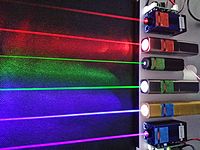
Photo from wikipedia
Gold nanoparticles (Au NPs) with surface plasmonic resonance (SPR) effect and excellent internal electron transfer ability have widely been combined with semiconductors for photocatalysis. However, the in-depth effects of Au… Click to show full abstract
Gold nanoparticles (Au NPs) with surface plasmonic resonance (SPR) effect and excellent internal electron transfer ability have widely been combined with semiconductors for photocatalysis. However, the in-depth effects of Au NPs in multicomponent photocatalysts have not been completely understood. Herein, ternary titanium oxide-gold-cadmium sulfide (TiO2-Au-CdS, TAC) photocatalysts, based on hierarchical TiO2 inverse opal photonic crystal structure with different Au NPs sizes have been designed to reveal the SPR effect and internal electron transfer of Au NPs in the presence of slow photon effect. It appears that the SPR effect and internal electron transfer ability of Au NPs, depending on their sizes, play a synergistic effect on the photocatalytic enhancement. The ternary TAC-10 photocatalyst with ~ 10 nm Au NPs demonstrates an unprecedented hydrogen evolution rate of 47.6 mmolh-1g-1 under visible-light, demonstrating ~ 48% enhancement comparing to the sample without slow photon effect. In particular, a 9.83% apparent quantum yield under 450 nm monochromatic light is achieved for TAC-10. A model is proposed and finite-difference time-domain (FDTD) simulations reveal the size influence of Au NPs in ternary TAC photocatalysts. This work suggests that the rational design of bifunctional Au NPs coupling with slow photon effect could largely promote hydrogen production from visible-light driven water splitting.
Journal Title: Journal of colloid and interface science
Year Published: 2021
Link to full text (if available)
Share on Social Media: Sign Up to like & get
recommendations!